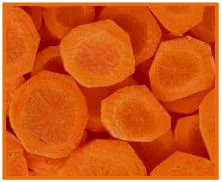 The scientists at University of Limerick (Ireland) have conducted different experiments to investigate the effects of cutting operations (slicing and peeling methods) and storage conditions (gas atmosphere and temperature) on levels of contamination and penetration of Escherichia coli O157:H7 cells in fresh-cut carrots.
The scientists at University of Limerick (Ireland) have conducted different experiments to investigate the effects of cutting operations (slicing and peeling methods) and storage conditions (gas atmosphere and temperature) on levels of contamination and penetration of Escherichia coli O157:H7 cells in fresh-cut carrots.For the study, following treatments were tested:
- Carrots were sliced into disks, either manually or by machine, in the latter case the machine was equipped with either blunt or sharp cutting blades;
- Carrots were peeled manually by using hand-held peeler or mechanically by using an electric abrasion peeler;
- Fresh-cut carrots were stored at 8°C for 5 days in 20% CO2 – 1% O2- 79% N2 or in 5% CO2 – 3% O2 – 92% N2;
- Fresh-cut carrots were stored at 4°C (recommended temperature) or 10°C (improper temperature) for 5 days.
The depths sampled in carrots discs were: 0-25, 225-250, 475-500, 725-750, and 975-1000 µm.
Results showed that cutting vegetables by using blunt blades favours the Escherichia coli cells penetration and their survival at 8°C. Moreover, the number of bacterial cells was higher and the cells penetrated deeper (475-500, 725-750 e 975-1000 µm) into carrots cut with blunt blades than into carrots cut manually with a razor blade. Also after 5 days of storage, the bacterial load remained higher at all depths sampled in carrots cut with blunt blades.As regards peeling methods, no significant effects were found on penetration and survival of Escherichia coli cells.
As regards storage conditions, the gas atmosphere with 20% CO2 and 1% O2 resulted in favouring the bacterial cell survival at the surface and within carrot tissue compared to the gas atmosphere with 5% CO2 and 3% O2. In addition, the scientists observed that a mild abuse temperature, such as 10°C in this case, favoured the pathogen survival at all depths sampled.
In all experiments, the scientists have found that Escherichia coli O157:H7 cells growing on the surface survived better than cells penetrating into carrot tissue.
Scientists conclude by highlighting the importance of this data to improve the microbial safety of fresh-cut produce, because this study has demonstrated that the use of sharp blades for cutting operations during harvesting and processing can reduce the penetration depth of a potential Escherichia coli contamination and enhance the antimicrobial efficacy of dipping operations foreseen during minimal processing.
Source: O'Beirne D., Gleeson E., Auty M., Jordan K., ‘Effects of processing and storage variables on penetration and survival of Escherichia coli O157:H7 in fresh-cut packaged carrots’, 2014, Food Control, Vol. 40, pagg. 71-77. Further info: http://www.sciencedirect.com/science/article/pii/S0956713513006087
